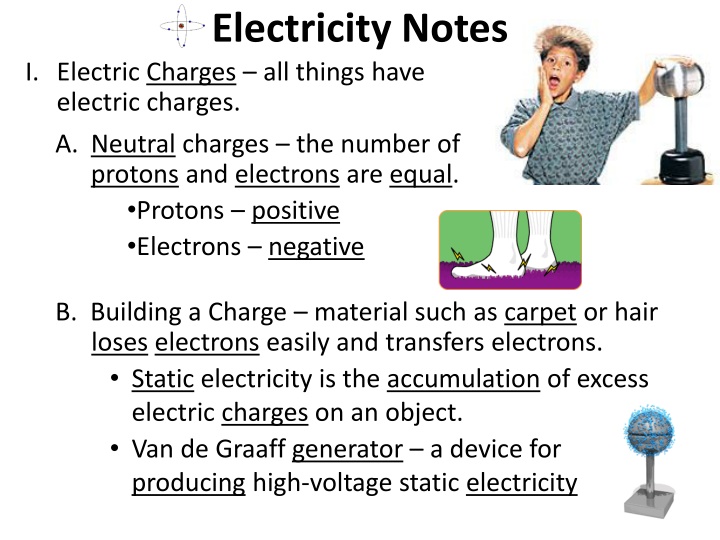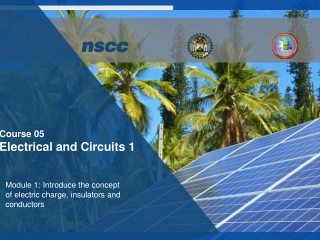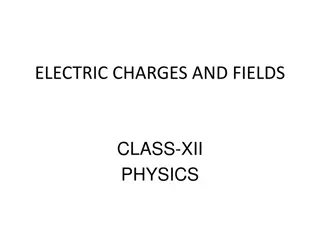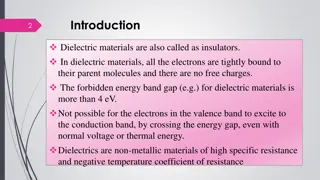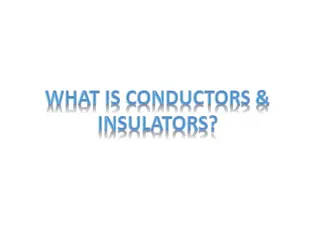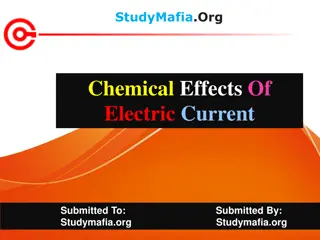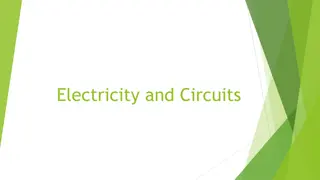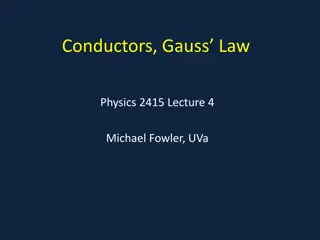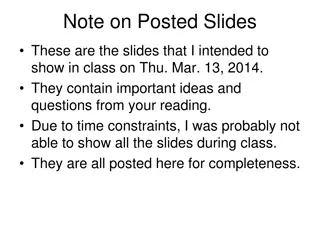Electricity: Charges, Conductors, Insulators, and Storms
Explore the fundamentals of electricity, including electric charges, neutral charges, static electricity, conductors, insulators, lightning storms, and the phenomenon of lightning strikes. Learn about the laws of conservation of charge, electric fields, and the properties of conductive and insulating materials.
Uploaded on Oct 03, 2024 | 1 Views
Download Presentation

Please find below an Image/Link to download the presentation.
The content on the website is provided AS IS for your information and personal use only. It may not be sold, licensed, or shared on other websites without obtaining consent from the author.If you encounter any issues during the download, it is possible that the publisher has removed the file from their server.
You are allowed to download the files provided on this website for personal or commercial use, subject to the condition that they are used lawfully. All files are the property of their respective owners.
The content on the website is provided AS IS for your information and personal use only. It may not be sold, licensed, or shared on other websites without obtaining consent from the author.
E N D
Presentation Transcript
Animation Electricity Notes I. Electric Charges all things have electric charges. A. Neutral charges the number of protons and electrons are equal. Protons positive Electrons negative Socks producing static electricity B. Building a Charge material such as carpet or hair loses electrons easily and transfers electrons. Static electricity is the accumulation of excess electric charges on an object. Van de Graaff generator a device for producing high-voltage static electricity
C. Conservation of Charge Law of Conservation applies to charges in the fact that charges cannot be created or destroyed, but only transferred. Opposites attract opposite charges attract and like charges repel. Electric Fields an electric field surrounds every charge.
II. Conductors and Insulators A. Conductors allow electrons to move easily. Metals are excellent conductors. Semiconductor material such as silicon and germanium that are neither a good conductor nor insulator. Only can be used as a conductor if impurities are added. B. Insulator material that does NOT allow electrons to move through easily.
III. Storms and Electricity A. Lightning is a static discharge. Static discharge is a transfer of electric charges through the air between two objects because of a buildup of charges. B. Thunder caused by the heat energy of lightning.
What Gives Lightning it's Zap? Lightning happens when the negative charges (electrons) in the bottom of the cloud are attracted to the positive charges (protons) in the ground.
What Gives Lightning it's Zap? The accumulation of electric charges has to be great enough to overcome the insulating properties of air. When this happens, a stream of negative charges pours down towards a high point where positive charges have clustered due to the pull of the thunderhead.
What Gives Lightning it's Zap? The connection is made and the protons rush up to meet the electrons. It is at that point that we see lightning and hear thunder. A bolt of lightning heats the air along its path causing it to expand rapidly. Thunder is the sound caused by rapidly expanding air. tree3ani
D. Grounding connecting an object to Earth with a conductor. The earth is a large neutral object such that if a conductor is connected to the Earth, it will ground out or become neutral. Lightning rods are used in homes to ground out.
IV. Electrical Pressure A. A voltage difference is the push that causes charges to move and is measured in volts (V). B. Charges flow from high voltage areas to low voltage areas. +
V. Circuits A. Closed Circuits a closed, conducting path. The flow of charges through a wire is the electric current. The electric current is measured in amps. Current is almost always the flow of electrons.
B. Electric Circuits To use electrical energy, a complete circuit must be made. Circuits typically include a voltage source, a conductor such as wire, and one or more devices that use the electrical energy to do work. closed_circuit
C. Series Circuits In a series circuit, the current only has one loop to flow through. Series circuits are used in flashlights and holiday lights. D. Parallel Circuits Parallel circuits contain two or more branches for current to move through. Most houses are wired with parallel circuits.
E. Household Circuits Most household wall sockets are 120 V while the dryer and stove requires a 220 or 240 V. All household circuits contain either a fuse or a circuit breaker.
VI. Circuit Overload Protection A. Fuses An electrical fuse contains a small piece of metal that melts if the current becomes too high. Too many appliances in use at the same time is the most likely cause for the overheating of the circuit. B. Circuit breaker a circuit breaker is a guard against overheating. A circuit breaker contains a piece of metal that bends when it gets too hot. The bending causes a switch to flip and open the circuit.
VII. Batteries a battery is a device used to maintain a voltage difference. A. Dry-Cell Batteries A dry cell battery is the typical individual batteries used. Ex (AA,D) There is a positive and negative terminal on each battery, causing a voltage difference. The voltage difference causes a circuit to flow. B. Wet Cell Batteries A wet cell battery contains two connected plates made of different metals in a conducting solution. An example of a wet celled battery is a battery used in a car. As a car is driven, the alternator recharges the battery by sending current through the battery in the opposite direction to reverse the chemical reaction.
VIII. Resistance the tendency for a material to oppose the flow of electrons, changing electrical energy into thermal energy and light. Resistance is measured in Ohms ( ). Thinner wires have a greater resistance to electron flow, as opposed to thicker less resistant wires. Longer wires have more resistance than shorter wires.
IX. Ohms Law Current (I) is measured in Amperes (amps). Voltage (V) difference is measured in Volts. Resistance (R) is measured in Ohms. current = voltage difference/resistance
X. Electrical Power the rate at which electrical energy is converted to another form of energy. Power is measured in Watts. Current is measured in amps. Voltage is measured in volts. Power = current X voltage
XI. Electrical Energy the amount of electrical energy you use depends on two things: 1. Power required 2. How long it is used Calculating Electrical Energy Energy is measured in kilowatt-hours (kWh). Power is measured in kilowatts (kW). Time is measured in hours (h). Energy = Power X time
